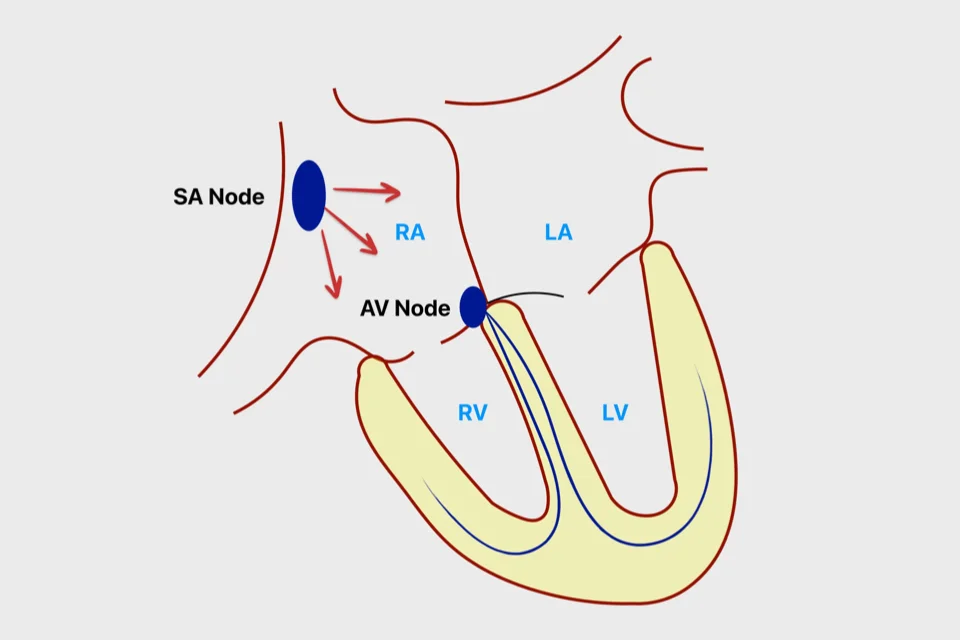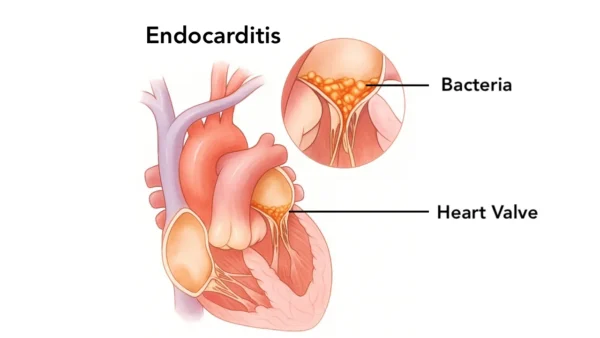Overview
Atrial Fibrillation (AFib) is the most common type of irregular or rapid heartbeat that affects the upper chambers of your heart, called the atria. Instead of beating in a smooth, organized way, the atria quiver or “fibrillate,” sending fast and chaotic electrical signals to the lower chambers. You should know that while AFib is common and can feel scary, it is highly treatable, and getting the right help allows you to live a full and active life. However, you must take it seriously because an irregular heartbeat increases the risk of blood clots and stroke.
The heart’s rhythm is normally controlled by a natural pacemaker, but with Atrial Fibrillation, this control breaks down, causing the upper chambers to beat anywhere from 300 to 600 times per minute. When your heart beats this fast and chaotically, it does not empty blood completely, which is why blood can pool and form clots. Your doctor’s primary focus in treating AFib is to both manage your heart rate and prevent these dangerous clots from forming.
Symptoms
The main symptom of Atrial Fibrillation is often a noticeable fluttering or racing sensation in your chest, which people commonly call palpitations. Your heartbeat feels completely irregular—sometimes fast, sometimes slow, and usually erratic—and you might feel dizzy or short of breath because the heart is not pumping blood efficiently. You should pay close attention if you suddenly feel very tired or weak, especially during normal activities, because AFib can dramatically reduce your body’s energy supply.
While many people feel a distinct fluttering, others may feel no immediate discomfort at all. Recognizing the signs of Atrial Fibrillation symptoms is key to getting diagnosed quickly. Here are the most common ways this irregular rhythm affects your body:
- Heart Palpitations: A feeling that your heart is skipping, fluttering, or pounding irregularly in your chest.
- Dizziness or Lightheadedness: Feeling faint or unsteady because your brain is not getting enough consistent blood flow.
- Shortness of Breath: Having trouble catching your breath, especially when you are active or lying flat.
- Severe Fatigue: Feeling overly tired with no energy, even after a full night’s sleep.
- Chest Discomfort: Feeling pressure, tightness, or pain in your chest, which can be alarming.
Causes
The main cause of Atrial Fibrillation is often damage to the heart muscle or existing conditions that place a large strain on the heart, leading to problems with its electrical wiring. Over time, high blood pressure, coronary artery disease, or heart valve problems can stretch and scar the upper chambers, disrupting the normal electrical signals. You must understand that AFib usually results from a combination of these underlying heart conditions and other health factors that affect your overall cardiovascular system.
Many different factors can act as triggers or root causes of Atrial Fibrillation by stressing the heart’s electrical system. Your doctor will work with you to identify and manage these conditions:
- High Blood Pressure (Hypertension): Chronically high pressure makes the heart work harder, leading to wall stiffness and electrical changes.
- Coronary Artery Disease: Blocked or narrowed arteries reduce blood flow to the heart muscle, making it vulnerable to electrical disruption.
- Heart Valve Disease: Issues with the valves (like narrowing or leaking) place stress on the heart chambers.
- Overactive Thyroid: Too much thyroid hormone can speed up the heart, triggering irregular rhythms.
- Sleep Apnea: Untreated sleep apnea can cause major drops in oxygen levels, which puts stress on the heart overnight.
- Excessive Alcohol or Caffeine: Overuse of these substances can sometimes trigger episodes in susceptible individuals.
Diagnosis
When you visit your doctor, they will use several simple and painless tests to confirm your Atrial Fibrillation diagnosis and check the health of your heart. The primary tool is the Electrocardiogram (ECG), which records your heart’s electrical signals and clearly shows the irregular, rapid activity in the upper chambers. If AFib comes and goes, your doctor may ask you to wear a small, portable monitor for a day or two to catch the rhythm when it happens. Getting the diagnosis confirmed quickly helps you start the right medications to protect yourself from stroke.
Treatment
The main goals of Atrial Fibrillation treatment are to control your heart rate, restore a normal rhythm if possible, and most importantly, prevent stroke. To prevent clots, your doctor will prescribe blood-thinning medication (anticoagulants). To manage the rate and rhythm, you take medications that slow the chaotic signals or help the heart stay in a regular beat. You should know that with the right combination of medications, you can effectively manage AFib and feel much better very quickly.
Your doctor tailors the treatment for Atrial Fibrillation based on your overall health and the type of AFib you have. The main approaches involve medication and sometimes special procedures:
- Stroke Prevention (Anticoagulants): You take blood thinners (like warfarin or newer medications) to significantly reduce the risk of a clot forming and traveling to the brain.
- Rate Control Medications: These medicines, such as beta-blockers or calcium channel blockers, slow the overall heart rate so the lower chambers do not beat too fast, making you feel better and improving blood flow.
- Rhythm Control Medications (Antiarrhythmics): These drugs help restore and maintain the heart’s normal electrical rhythm, preventing the chaotic signals from starting.
- Cardioversion: This procedure is sometimes used to “reset” the rhythm. The doctor delivers a controlled, quick electrical shock to the heart while you are asleep to temporarily stop the AFib and let the heart restart in a normal rhythm.
- Ablation: This advanced procedure involves the doctor using thin wires (catheters) to find and carefully destroy (ablate) the small areas of heart tissue that are causing the chaotic electrical signals.
Risks
While Atrial Fibrillation is highly manageable, you must be aware of the serious risks associated with it, especially if the condition is left untreated. The most significant concern is the risk of stroke, which is five times higher in people with AFib because blood can pool and form clots in the quivering upper chambers. These clots can then travel to the brain. You take a critical step in protecting yourself by consistently taking the blood-thinning medication prescribed by your doctor.
In addition to the increased risk of stroke, there are other important Atrial Fibrillation risks that can damage your heart over time:
- Stroke: Clots forming in the atria break off and block blood vessels in the brain, leading to permanent damage.
- Heart Failure: If the heart beats too fast for too long, the muscle can become weak and less efficient, eventually failing to pump enough blood to the body.
- Chronic Fatigue: The inefficient and irregular pumping action reduces the body’s overall blood supply, causing long-term, debilitating tiredness.
Prevention
The best way for Atrial Fibrillation prevention is to adopt a heart-healthy lifestyle and aggressively manage any underlying conditions that damage your heart. You can greatly reduce your risk by keeping your blood pressure and cholesterol levels within a healthy range and maintaining a healthy weight. You take control of your heart health when you focus on making these important lifestyle changes every day.
To focus on Atrial Fibrillation prevention, you should concentrate on actions that reduce strain on your heart and stabilize its electrical system:
- Manage Blood Pressure and Cholesterol: Follow your doctor’s advice for medication and diet to keep these numbers healthy.
- Maintain a Healthy Weight: Losing excess weight reduces the overall strain on your cardiovascular system.
- Limit Alcohol and Caffeine: Reducing or eliminating these can help prevent AFib triggers, especially if you know they affect your heart rhythm.
- Be Physically Active: Regular, moderate exercise strengthens your heart muscle and improves overall blood flow.
- Quit Smoking: Smoking damages the heart and blood vessels, significantly increasing the risk of AFib and stroke.
When to See a Doctor
If you suddenly feel a severe fluttering, racing, or pounding heartbeat that does not go away, you must know when to see a doctor for Atrial Fibrillation symptoms. If the irregular heart rhythm is accompanied by chest pain, severe dizziness, or fainting, you need emergency medical attention immediately. You should not wait for these symptoms to pass; contacting a doctor quickly allows them to confirm the rhythm and start the necessary protection against stroke.
Even if the symptoms are not life-threatening, you should consult your doctor immediately if you notice:
- New or Frequent Palpitations: If you notice your heart fluttering or racing regularly, even if it eventually stops.
- Unexplained Fatigue: If you feel much more tired than usual and struggle with everyday tasks.
- Signs of Stroke: This is an emergency. If you suddenly have difficulty speaking, drooping on one side of your face, or sudden weakness in an arm or leg, call emergency services immediately.
You may also like to read these:
Reference: Atrial Fibrillation






